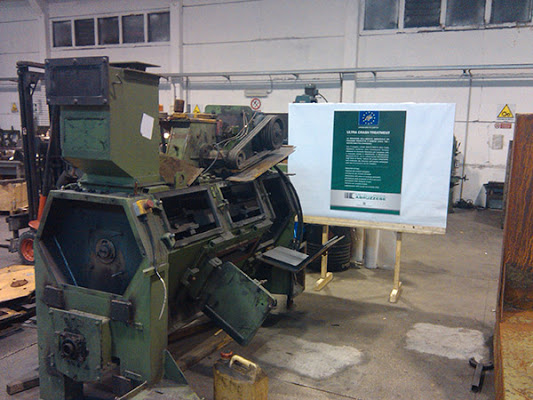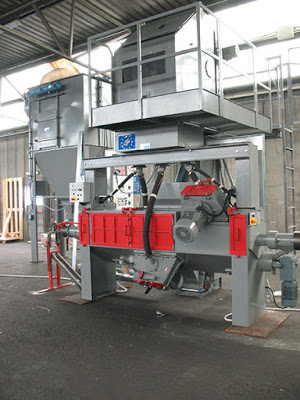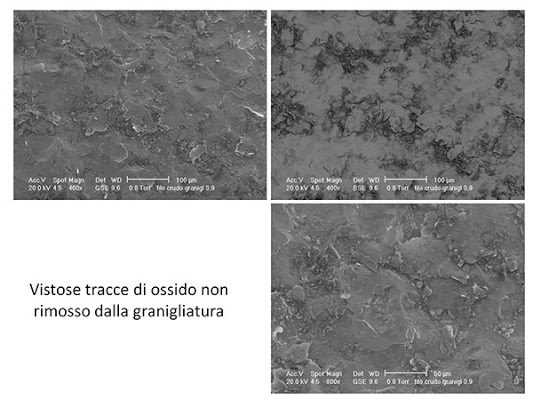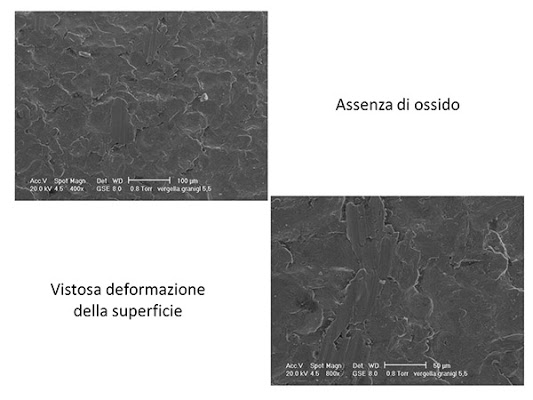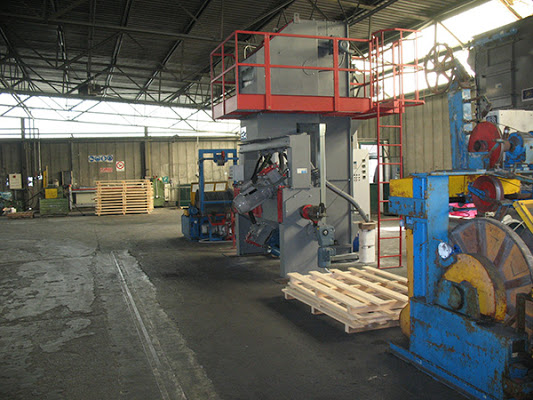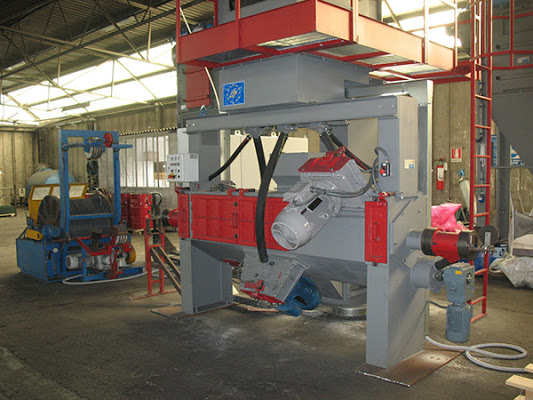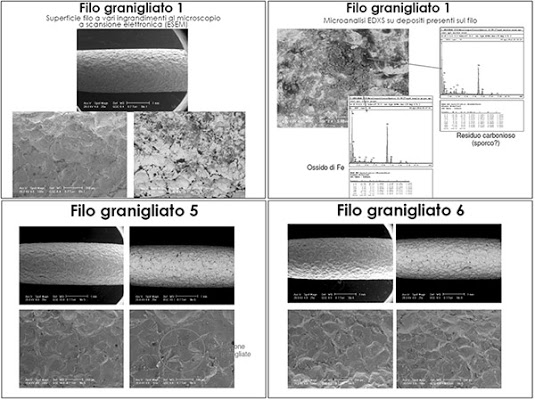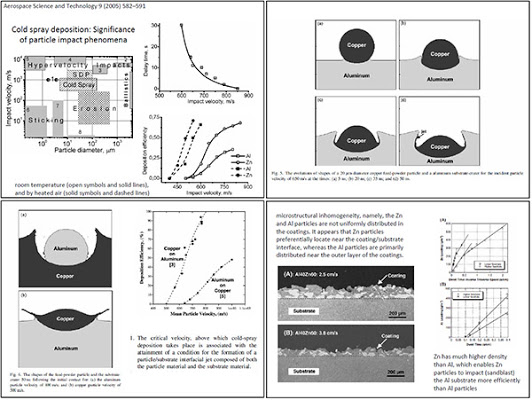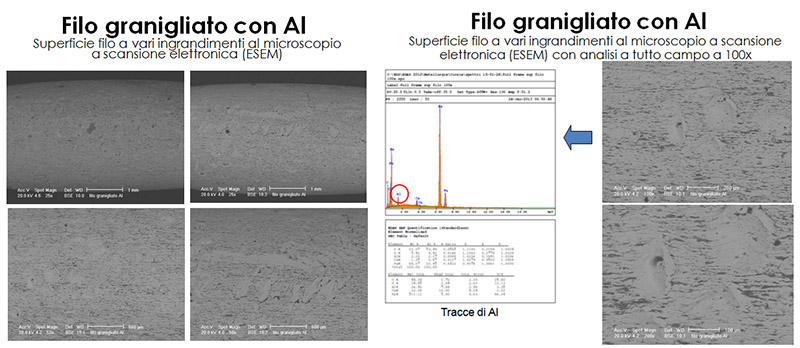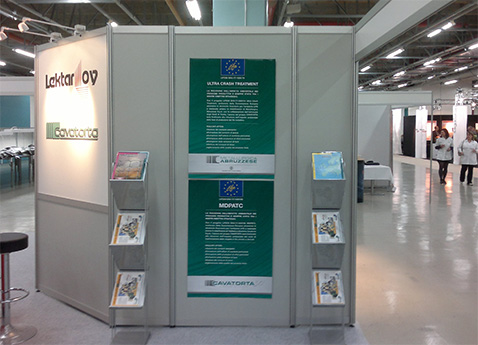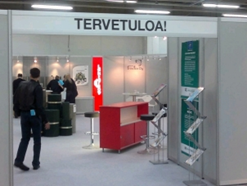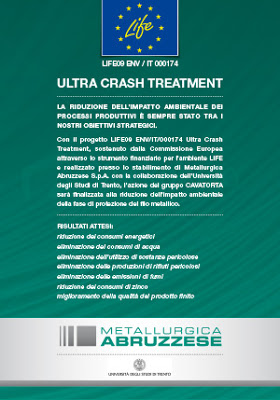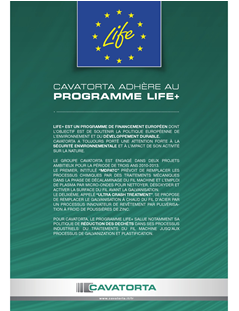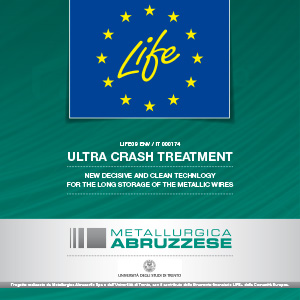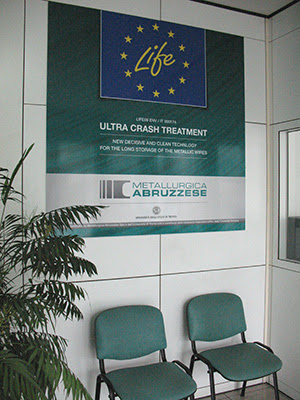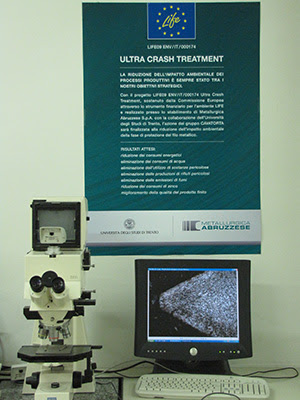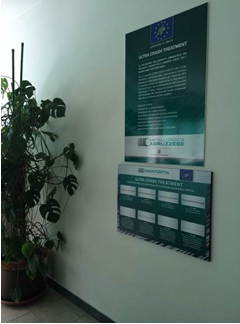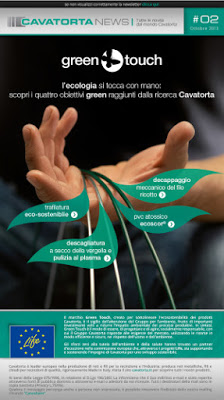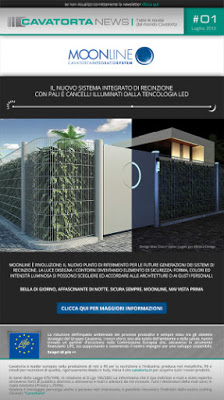The second project, started in autumn 2010 and concluded in autumn 2013 in the Metallurgica Abruzzese factory with the collaboration of the University of Trento as partners of the project, established the operation taking place at the exit of a traditional annealing furnace of drawn wire.
The main innovations of this project are:
- a phase of ceramic micro shot blasting, able to clean perfectly the surface of the annealed wire in place of pickling in an acid bath without damage;
- a final phase of a conformal coating of the wire by means of cold spraying (cold spray) of zinc powders.
SEE THE DISSEMINATION OF THE RESULTS
Documents
- Download the brochure in PDF format
- Download the article published on Il Centro in dicember 2011
- Download the article published on Il Centro in november 2013
- Download the article published on Tecnologia del Filo in november 2013
- Download the Layman’s Report
- LIFE09-ENV-IT-174_Technical-Report
LIFE+ PROGRAMME
The (EC) No 614/2007 Regulation of the European Parliament and of the Council of 23/05/2007 established the new European Programme for the financial support of products and technologies aimed at protecting the environment: LIFE +.
LIFE + replaces the previous LIFE program (Environment, Nature and Third Countries), the Community Framework Programme for cooperation in promoting sustainable urban development, the Community Action Programme for the promotion of non-governmental organizations active in the field of environmental protection and Forest Focus program.
The objective of LIFE is to contribute to the development, implementation and updating of policy and legislation on the environment. This financial instrument is also designed to facilitate the integration of environment into other policies and to contribute to sustainable development in the European Union.
LIFE + co-finances environmental activities in the European Union (EU) and in certain third countries (EU accession countries, members of the European Environment Agency, the Western Balkan countries affected by the process Stabilisation and Association). The funded projects may be proposed by operators, public and private bodies or institutions.
LIFE + consists of three thematic components:
- Nature and Biodiversity. The Nature projects contribute to the implementation and development of the guidelines “Birds”, “Habitat” and the Natura 2000 network. Biodiversity projects focus on innovative practices aimed at halting the loss of biodiversity in Europe.
- Environmental Policy and Governance. It supports innovative or demonstration projects that show innovative solutions relating to relevant environmental issues.
- Information and Communication. It supports projects aimed at the communication and awareness campaigns on the environment, and training initiatives and campaigns for the prevention of forest fires.
BACKGROUND & OBJECTIVES
One of the most popular and effective protection of the wire is the galvanic coating or galvanizing. The wire should be subjected to degreasing, pickling, fluxing and preheating to 100 ° C, before being immersed in a bath of molten zinc at 455 ° C.
This system does have a strong environmental impact:
- Very high energy (300,000 kcal / ton)
- Consumption of water (100 l / ton)
- Use of dangerous substances (1 kg / ton)
- Production of waste (10 kg / ton of dust, zinc dross and foams)
- Air emissions (1000 m3/ton fumes from plating baths containing ammonia, hydrogen chloride, zinc dust and other zinc-containing)
The aim of the project is to replace the current phase of hot dip galvanizing with a more environmentally innovative technology, greatly reducing the impact of the process of securing the wire.
PROJECT
The Cavatorta Group, long known for its commitment to environmental protection, has developed a new environmentally friendly process for galvanization of ferrous materials.
This led to the new project Ultra Crash Treatment, which won a prestigious award from the European Commission under the LIFE + financial support, which has recognized the innovative nature of the project and the environmental contribution that this sector can make.
The project, under construction at Metallurgica Abruzzese SpA aims to replace the process of hot dip galvanizing of steel wire with an innovative coating process by spraying cold zinc dust: this process resolves all environmental issues related to the hot dip galvanizing.
This treatment will be preceded by preliminary micro shot peening ceramics, which will allow on the one hand the product activation for optimal adhesion of the zinc, the other phases of the elimination of degreasing, pickling, fluxing and preheating.
The project therefore involves the construction of two prototypes: one for micro shot peening ceramics and the other for cold galvanizing spray.
The technologically innovative aspect of the project is then represented by the inclusion of such technology in an area in which they are not used. Exceptional partner of the project is the Department of Materials Engineering and Industrial Technologies, University of Trento, directed by Prof. Alberto Molinari.
DEVELOPMENT ACTIONS
The project is divided into three macro-activity:
1.
Study, design and development of the treatment process by means of wire micro shot peening ceramic (ceramic micro shot peening study of wire rod and wire; micro shot peening prototype design, construction, installation, testing and validation of the prototype for micro shot peening ceramic). In this phase the collaboration of the University of Trento will be particularly important, which will have the task of testing the laboratory prototype, analyze the results and contribute to the design of the system micro shot peening. Metallurgica Abruzzese will be responsible for design, test and debug the system micro shot peening ceramics in its final configuration.
2.
Study, design and development of the process of galvanizing cold-spray (study of the zinc coating by spraying cold; prototype design of cold-galvanizing spray, construction, installation, testing and validation of the prototype for cold galvanizing spray). In this activity, the University of Trento will be responsible for research on conventional cold-spray systems and the definition of treatment parameters, facilitating Metallurgica Abruzzese in the analysis of test results. Metallurgica Abruzzese will design, develop and test the new system of cold-galvanizing spray.
3.
New lay-out of the process obtained by the assembly of the two previous steps (assembly and connection of the Two prototypes described earlier to form the pilot line, pilot line connection with the production cycle, testing and experimentation of operation and process validation).
EXPECTED RESULTS
Environmental Benefits
- Allow the micro shot peening ceramic, compared to the traditional blast or descaling, a decrease of energy consumption by 50%;
- The new cold galvanizing spray will allow a substantial reduction of energy consumption by about 56% for the current stages of drying, cooling and galvanizing takes about 300,000 kcal / ton of product, using the cold spray method, the consumption will be reduced to about 130,000 kcal / ton;
- Total elimination of waste (about 10 kg / ton of ash, zinc skimming and matte zinc);
- Total elimination of smoke emissions into the atmosphere (1000 m3/ton smoke from the galvanizing bath containing toxic substances: ammonia, hydrogen chloride and zinc dust);
- Significant improvement of the working environment.
Technical and economic benefits
- Increase the efficiency of oxide removal system with less roughness (switching from a roughness (Ra) greater than 5 μm with a roughness of less than 3 μm), a consequential reduction in the thickness of the zinc layer deposited the order of 30%, there is also a reduction in treatment time up to 10 times, and the amount of flow of about 3 times;
- Reduction of the deflection of the lower energy limits the average cold deformation induced by the transformation of the kinetic energy of the shot in cold plastic deformation of the surface of the wire subjected to treatment;
- Reduction in consumption of machine parts subjected to the flow of micro-dots, estimated in 70%;
- Significant reduction in the consumption of zinc, estimated at 35%, with obvious economic effects.
THE PROJECT
The project regularly started in October 2010.
First the management and monitoring actions were planned, involving the partner University of Trento, who have been allowing the project to run smoothly, as according to the times, objectives and expected costs. From the technical point of view, the project started with a first phase of bibliographical study, conducted by the University of Trento, to select the information available in the international literature on the effects of micro shot peening. Meanwhile, in Metallurgica Abruzzese a first shot-blasting was made, suitably modified to operate on the drawn wire and with the use of metal abrasives in the form of microspheres or small cylinders (FIG 1). The first tests carried out have shown the removal of the oxides present on the annealed wire, but also the formation of surface damage (FIG 2 and 3).
Based on the results of the experiment, carried out both in Metallurgica and at an outside company with which the University of Trento has cooperative relations, the design and construction phase began of the micro shot peening plant (FIG. 4). The micro shot peening plant operates with three turbines installed in line and arranged so as to act over the whole surface of the wire in transit, it is able to recover and reuse the abrasive material separating it from the waste product, as well as to operate both with ceramic micro balls, small spheres and metal cylinders.
From the tests carried out by the University of Trento, it was in fact noted that the system of micro shot peening, while ensuring thorough cleaning of the wire and negligible damage to the surface of the product in transit, increases the mechanical resistance thereof to strain hardening of the wire itself. For this reason, in consideration of the particular adhesion mechanism of the zinc layer produced with cold spray, it was considered more suitable to use the micro shot blasting process, which still ensures a good cleaning of the wire and does not cause excessive strain hardening.
The accurate experimental phase carried out in the Metallurgica Abruzzese factory, set upon a DoE approach (Design of Experiment), has yielded excellent results, with traces of oxide being virtually absent; they then showed the perfect achievement of the objectives set, and confirmed the expected productivity for the plant and the level of required cleanliness of the wire. (FIG. 5)
At the same time, the action related to the new galvanizing system was started by means of cold spraying.
Also in this case, the activity started with a research performed by the University of Trento, although in this case, the literature in the field of cold zinc coating is very poor (FIG. 6). In any case, the international literature highlights some aspects which affect the success of the coating with such technology (in particular, the need that also the substrate gets deformed in contact with the balls of zinc, something which has made the use of the micro shot peening system less desirable, as described previously).
After a series of preliminary tests at an outside company (however on wire portions, using a static galvanizing system), the cold galvanizing system was designed and implemented, which also operates with turbines instead of pneumatic guns, in order to ensure greater output speed of the zinc balls and therefore a greater adhesion of the coating to the metal substrate.
The aforementioned plant, however did not prove capable of achieving the programmed objectives, both in terms of ability to recoat the wire, particularly with the tests carried out with aluminium (FIG. 7) and in terms of production capacity.
It was therefore redesigned, providing for the use of turbines with higher output power and the possibility to deal with 6 wires at the same time, the new plant was then delivered and launched in February 2013 (FIG. 8). This plant, however, also required a delicate stage of development, including the replacement of the turbines and the reprogramming of the electronic management of the same; the experimental phase thus started in May.
The new process lay-out therefore concluded with the installation of the two systems described above and, thus, with the realization of the pilot line, which operates according to a “semi-continuous” process, in order to match the different operating speeds of the plant, maintaining the production capacity maximized. The recoating tests, currently underway, are giving good results, which will guide the testing required for the development of the system; in addition to the galvanizing tests, aluminizing tests are also currently underway, a treatment that is currently not possible because of such a high environmental impact.
Updated May 2013
ALUMINIZING TESTS
The tests of coating with zinc gave immediately good results, which led the testing required for the finalization of the system. In addition to galvanizing tests, however, were also carried out aluminizing tests, a treatment currently not possible because of its very high environmental impact.
These tests were carried out for a number of reasons:
- Aluminium is preferable to zinc for certain uses, because aluminised wire has a considerably higher corrosion resistance compared to simply galvanized wire, especially in a saline environment.
- Aluminizing is a process with an high environmental impact, therefore it is not used in the steel industry.
- The use of zinc-aluminium eutectic alloys is spreading, but this is not possible with cold galvanizing, because in this case the two metals do not form an alloy.
- To ensure the quality results required, it is preferable to use primary zinc, with a well-defined minimum degree of purity; the zinc recycling process is not very widespread and produces a poor quality raw material, therefore only partially usable; the recovery cycle of aluminium is an established practice, and recycled aluminium has properties equivalent to the original one, and energy consumption for its production is much lower than that for the production of primary aluminium.
- Zinc is considered a rare metal and its extraction is concentrated in a few countries (mainly China, Australia and North America); aluminium is plentiful in nature, and it is produced in all continents and about 1 / 4 of the entire world production of aluminium comes from the recycling industry.
The results obtained however, have proved unsatisfactory. This is caused by a number of factors:
- The density of aluminium is considerably lower than the density of zinc (7.13 g/cm3 vs. 2.7 g/cm3); therefore, if the volume is the same, the kinetic energy of aluminium is 2.6 times lower than that of zinc (E = 1/2 m * v2); when in contact with the iron substrate of the wire to be coated, the deformation of the aluminium will be lower, as well as the ability to interact with the substrate or with other particles already deposited, thus deforming and compacting them. The layers of Aluminium therefore result less dense and with porosity or discontinuities; in order to avoid this drawback, in other sectors co-spraying of ceramic particles is often adopted, to increase the kinetic rate; the ceramic particles however are incorporated in the coating and therefore this method cannot be used for the project.
- Aluminium rapidly forms a hard and brittle surface oxide (alumina), which reduces the adhesion and cohesion of the coating layer; with Zinc this occurs less, also because the greater kinetic energy favours the breakage of the oxide film.
- Aluminium and its alloys harden very quickly, i.e. the mechanical properties increase if they are deformed (hardened materials deform less and break more easily). Zinc alloys, however, recrystalise at room temperature, becoming less hard and less brittle, thus allowing the wire to be subjected to subsequent processing (for example, mechanical bending and welding for the construction of mesh).
In light of the above, while considering extremely interesting the possibility of replacing, at least for certain products, zinc with aluminium for the protective coating of the metal wire, we have interrupted the experiments in this sense because this objective was not among those foreseen by this project, and because the technology does not seem suitable to obtain the desired result.
RESULTS ACHIEVED
Metallurgica Abruzzese and the University of Trento have completed the “Ultra Crash Treatment” project within schedule, achieving the objectives set. The project was executed in line with what was foreseen in the application and the small variations that occurred did not affect the achievement of the expected results.
From a technical point of view the main environmental results obtained that can be measured in the long term are:
- significant reduction of energy consumption: about 70% less as regards wire cleaning and about 40% as regards the galvanising phase, with a reduction of over 200.000 Kcal/tonne in the first phase and over 110.000 Kcal/tonne in the second one. Considering that the company’s production is of about 40.000 tonnes per year, the possibility of extending, in the long term, the demonstrated process to the entire yearly production of the company would lead to savings of over 12.000 million Kcal. Considering that only at national level more than 4 million tonnes of wire are produced and more than 25 million are produced in Europe, the possible benefits in the long term are considerable.
- Thinner layer of zinc coating: about 36% less, which leads to a reduction in the consumption of zinc of about 40% with consequent environmental and economic benefits;
- 100% reduction of water for the cooling process (about 100 litres per tonne of wire): a saving of 4 million litres by the company if the technology is applied to the entire production. The possibility of substantial savings in the European context is a fact if the technology is disseminated, since the saving of water does not depend on the current situation of the plants or on the technology used; the implementation of the new technology in any case leads to 100% saving of water;
- No use of hazardous substances: about 40.000 kg per year of zinc chloride and ammonium in the company and more than 20 million kg estimated at European level;
- No production of waste, such as ash and zinc foam or solid zinc waste (slag), and subsequent disposal: approximately 350.000 kg of waste produced per year by the company would be saved if the proposed technology is industrialised; this value can be reach over 200 million kg at European level;
- Substantial reduction of emissions into the atmosphere, with total elimination of emissions from zinc baths: savings of approximately 400.000 m3 of smoke emissions containing ammonia, acids, zinc dust and zinc alloys.
Furthermore, additional benefits include:
- Shorter treatment times;
- Less wire deformation and consequently an improvement of performance in the galvanising phase;
- Less wear of machinery parts exposed to blasting;
The improvement of the working environment due to the production of smaller quantities of toxic dust must not be underestimated, since the benefits in this context are considerable and very much hoped-for.
DISSEMINATION OF THE RESULTS
Numerous measures were taken to guarantee maximum visibility of the project results and to raise awareness of the environmental problem. The dissemination strategy defined has achieved the main purpose set, i.e. of ensuring maximum impact within the European Community and bringing visibility to the project both inside and outside the iron and steel industry, involving public institutions as well as private-sector end users.
The activities implemented were also inspired by and organised according to a dissemination plan, which was constantly updated throughout the project based on the progress made and the commitments for the following period.
The main activities included:
- Creating and posting of this section dedicated to the Ultra Crash Treatment project in the company website, which has been updated and is easily accessible from the group’s website www.cavatorta.it, either using the link in the footer of the site, or from the “Research and Development” section. The leaflets produced and distributed at trade fairs can be downloaded from the website, which also contains a link to the project’s audio-visual material.
- With the new website, of which the LIFE section is part, a newsletter mailing plan was also set up, as a direct communication means for the dissemination of the “Ultra Crash Treatment” project, and two newsletters have been sent out, in September 2013 and December 2013. This system has replaced the house organ titled “Pagine”, which the Cavatorta Group no longer publishes. We will keep this activity going once the project has ended. The average number of pageviews is about 2500, out of the over 7000 mails sent out to contact details obtained and used directly by the company.
- Three different kinds of notice board have been produced: one 150×150 cm notice board, located in the reception area at Metallurgica Abruzzese S.p.A., on the premises where the company has both its office and production facilities; two 80×100 cm notice boards, including one located in the Metallurgica Abruzzese S.p.A. meeting room and the other (in Italian and English) used for dissemination activities, such as fairs and events; two 80×100 cm notice boards, located inside and outside the Metallurgy and Microstructures laboratory at the University of Trento’s Department of Materials Engineering;
- The tool chosen to circulate the flow of information, i.e. Internet, offers the highest dissemination levels available today, using online journals and industry portals. More specifically, an editorial product has been posted within the Edilportale site (www.edilportale.it), which is the most important portal in the Italian building industry, with over 300,000 members, and is used daily by professionals in the trade. The same publication was sent via newsletter to all the portal’s contacts. From October 2012 to October 2013 Edilportale helped bring around 90.000 visitors to Cavatorta products, through corporate pages bearing the LIFE logo, but above all around 300 page views for the company’s website and more than 700.000 recipients of the newsletter (photo dis7);
- The “Ultra Crash Treatment” project was also disseminated through a major article in the Italian-language magazine “Tecnologie del Filo” (Wire Technologies), the official house organ of the ACIMAF (Association of Italian Manufacturers of Machinery for Wire), which outlined the project in detail and the results achived (Download the pdf). Two editorials were published over the course of the project, in “IL CENTRO”, an Italian-language newspaper published by the L’ Espresso group, in both the printed and the online version, in 2011 and 2013. This has allowed us to highlight Cavatorta Group’s commitment to curbing the environmental impact of the processes linked to the industry within which Metallurgica Abruzzese S.p.A. operates, with particular attention to the LIFE projects underway. A mention of the project and the LIFE program were also included in the articles published in the Italian-language magazines “Impianti Solari”, “Progettare”, and “Casa e Giardino” in 2013.
- Particularly important was the participation in trade fairs. In October 2011, we took part in Helsinki’s FUR SHOW (Finland), with a Cavatorta Group stand which featured a section on LIFE projects and displayed the Metallurgica Abruzzese “Ultra Crash Treatment” posters (as well as the “MDPATC” project by ‘Trafileria e Zincheria Cavatorta’). English-language leaflets were also handed out. The company also took part in the BIG 5 SHOW (International Building & Construction Show) in Dubai, although not with its own stand. English-language leaflets were also distributed at the exhibition, which was considered strategic due to the great visibility offered (over 50,000 admissions), the considerable attendance of European actors, and because plenty of emphasis is place on the environmental aspect of products and processes (thanks to the 130 free seminars and the Green Build Congress). During 2013, Metallurgica Abruzzese exhibited at the ENOVITIS fair in Milan (Italy), from 12th to 16th November, which is known throughout the industry for its numerous sustainability-linked conferences and awards and at which project brochures and leaflets were distributed and the project was presented to the numerous visitors.
- The project can also be found in the “Think Eco Live Green” Facebook page, which has been created in association with other beneficiaries, through networking activities, and brings together various projects carried out in recent years in different sectors but with similar goals;
- Several samples of the product were produced and then displayed and distributed at meetings and to all those interested, even if they were simply visiting the company. Special display units were also produced and then distributed and used at trade fairs and events (photos dis13 e dis14);
- Bilingual leaflets and flyers were produced and then distributed at trade fairs and events either organised or attended. A pdf version of the leaflets is available for download on the website. There were also 5000 product catalogues produced for the French market, which featured a final page dedicated to Cavatorta Group LIFE projects underway. A Layman’s Report has been printed near the end of the project reporting the project summary and the activities realized (Download pdf);
- An audio-visual aid was also produced, accompanied by an explanatory booklet, which showed the new process developed by the “Ultra Crash Treatment” project and the relative environmental benefits. This material can also be viewed via the company’s website and on YouTube. A copy of the video was distributed during fairs and events and can also be viewed via the “Think Eco Live Green” Facebook page.
- The LIFE logo and the project number have been added to the new company letterheads. This paper is used for all business correspondence. A file version of the letterheads had been created first, after which the Life+ logo was integrated into the paper version when it was altered following the restyling of the company logos for the 50th anniversary of Cavatorta; the letterheads are now available in both printed and digital format.
- Two events during the project were determining for the dissemination of the project results. It was decided to bring the first event forward so that it would coincide with the 20th anniversary of the LIFE programme. So, working in association with Trafileria e Zincheria Cavatorta S.p.A, we organised an event to mark the LIFE anniversary, which was held on 5th June 2012 at Metallurgica Abruzzese S.p.A. During the event, both the LIFE projects implemented by the group were presented, as well as the 20 years of EU support through the LIFE action for environmental sustainability. The meeting was attended by local authority representatives (three local mayors and a provincial councillor), as well as representatives from the business world (industrialists from our and other fields), and from various associations (including the Confindustria association). The event included the presentation of the principles that inspired the creation of the LIFE instrument, the history of LIFE and the characteristics of the 2012 call for proposals, as well as a brief presentation of ongoing projects by Cavatorta Group. This was followed by an extremely interesting debate, which offered the opportunity for a comparison between European opportunities, businesses’ needs, and the situation of local public authorities. The meeting ended with a visit to the company’s factory, to show the technical progress of the “Ultra Crash Treatment” project.
- A second event (final event) has been held on 28 March 2014, at the conclusion of the project. During the event information on the results achieved in economic and environmental terms have been disclosed and product samples have been given to those interested. The turnout was fairly good and mainly involved representatives of the industry and universities as well as representatives of the public administration. During the final event the cooperation of those present for networking and transfer of technology was publicly requested; some companies have shown interest in this activity, therefore we believe that in future we will establish important contacts for the development of these actions. The events organised have given high visibility to the project and they have offered the opportunity to the staff to provide more information about the project to all stakeholders (photos dis20 e dis21).
- During the fairs in which we took part and especially due to the organisation of the events, for which numerous invitations were sent out, both in print and digital format, we have established important contacts with professional organisations, architects, engineers, landscape planners, eco-designers, especially the companies in the wire rod processing field located in Europe, the continental trading associations and a considerable number of operators in the field (wholesalers, retailers, agents, brokers) and potential entry-level customers (building firms, farming businesses, distribution chains), as well as public bodies and entities or final users.
The main goal of the dissemination strategy defined was to bring visibility to the project both inside and outside the iron and steel industry, involving public institutions as well as private-sector end users. This result can be deemed achieved.
